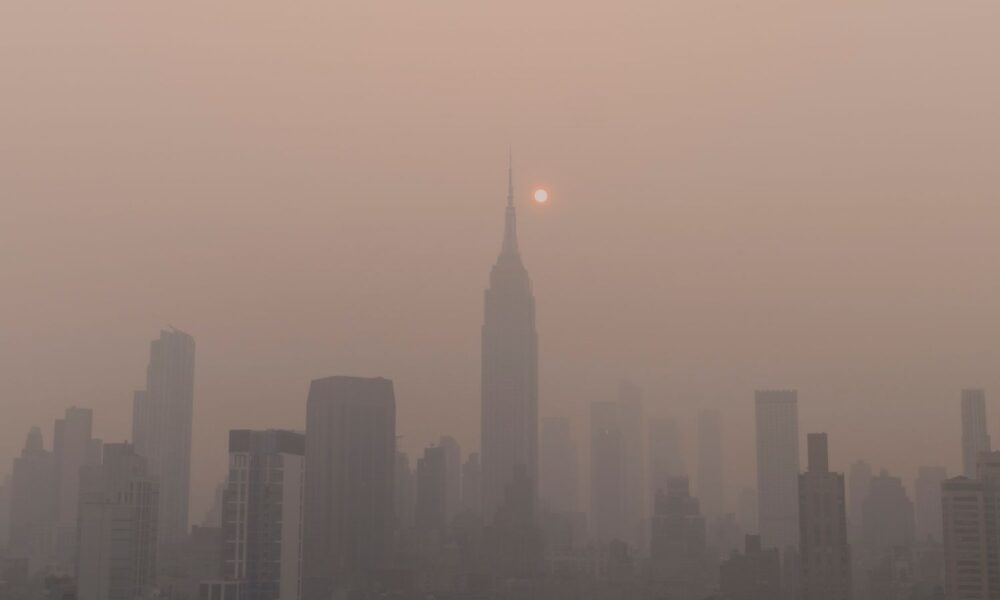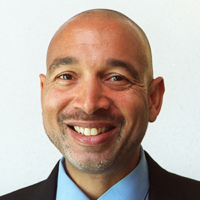The year is only half done and the United States has already been enveloped by acrid orange skies in the East, battered by winter rains and floods in California, seared by record winter temperatures in the South, soaked by a record 26-inch April deluge in Fort Lauderdale, and broiled by record spring heat in the Pacific Northwest, Texas, and Puerto Rico.
The onslaught has led to another round of media headlines and press releases from environmental and public health groups asking whether the nation is at a tipping point of urgency to fight climate change.
A Los Angeles Times headline for reader letters on the floods said, “California rains are a wake-up call for climate upheaval to come.” Many other media outlets and advocacy groups, from Al Jazeera to the American Lung Association, speculated as to whether the recent smoke plumes may also be such a “wake-up call.”
A Vox headline on the orange skies from Canadian wildfires said, “Wildfire smoke reminded people about climate change. How soon will they forget?” A Washington Post story carried the headline: “How the Canadian wildfire smoke could shift Americans’ views on climate.” A Philadelphia Inquirer column carried the headline, “America sleepwalks through a climate crisis. Will this smoke alarm wake us up?”
So far, no alarm bell has been loud enough to stop the sleepwalking. Hurricane Katrina in 2005, Superstorm Sandy in 2012, Hurricanes Harvey and Irma in 2017, and Hurricane Irma in 2021 were all accompanied by the same question. After the 2021 “heat dome” that saw Portland, Oregon hit 116 degrees and Seattle soar to 106, a Los Angeles Times headline said: “Northwest heat wave swamped the vulnerable, was a harsh climate wake-up call.”
The usual and eventual response to such things was summed up in an Associated Press story five years after Superstorm Sandy. The headline was “5 years after Superstorm Sandy, the lessons haven’t sunk in.” It was about most plans for climate security in the New York City area being unrealized.
A harsh new normal
Whether we wake up or not, a harsh climate is the new normal. To date in 2023, the United States has already suffered nine climate and weather disasters resulting in at least a billion dollars of damage, according to the National Oceanic and Atmospheric Administration.
That fits with the last five years, which have seen an annual average of 18 billion-dollar weather and climate disasters. That is a six-fold increase over the three such events a year during the 1980s, in adjusted dollars. Since 1980, hurricanes, severe storms, floods, and wildfires from billion-dollar events have cost the nation more than $2.5 trillion in damage and taken 16,000 lives. A quarter of the damages have come in just the last five years, causing major home insurers to astronomically raise rates in states seeing frequent severe weather and climate events, such as California, Florida, Louisiana, Arkansas, Texas, and Colorado. Allstate and State Farm have announced they will not issue any new homeowner policies in California.
This of course is not the entire picture as there are countless storms under $1 billion that still ravage communities and drain state budgets. “It is important to keep in mind that these estimates do not reflect the total cost of U.S. weather and climate disasters, only those associated with events more than $1 billion in damages,” NOAA says. “That means they are a conservative estimate of how much extreme weather costs the United States each year.”
According to one major global property database, nearly 15 million homes, or nearly 1 of every 10, was impacted in 2021 by natural disasters that are worsening with global warming, to the tune of $57 billion in property damage. Those costs are not yet steep enough. Part of that is that humans in the U.S. are normalizing the new normal, simply adapting to a seemingly incremental warmer environment rather than leap to action against an existential threat.
A 2019 study in the Proceedings of the National Academy of Sciences found that temperatures initially considered remarkable are unremarkable about five years later. The normalization effect is so strong that the study concluded: “It may be unlikely that rising temperatures alone will be sufficient to produce widespread support for mitigation policies.”
The study’s lead author, Frances Moore of the University of California Davis, said in a press release, “We saw that extreme temperatures still make people miserable, but they stop talking about it. This is a true boiling-frog effect (referring to the false myth that a frog will not feel gradually warming temperatures until it boils to death). People seem to be getting used to changes they’d prefer to avoid. But just because they’re not talking about it doesn’t mean it’s not making them worse off.”
Disinformation dulls urgency
Climate change denial and skepticism is a key feature of the deep political divide in this nation, fueled by long-running and coordinated campaigns of disinformation, often funded by fossil fuel interests. Most recently, as many cities broke pollution records and New York City momentarily recorded the worst air quality in the world from the plumes of smoke flowing down from Canadian wildfires, climate and pollution deniers blew their own smoke at the public on right-wing media.
The infamous fossil fuel and tobacco industry shill Steve Milloy falsely claimed on FOX News—which itself glorifies oil and gas and lambasts environmental regulations—that the wildfire smoke posed “no health risk.” Not-a-scientist Milloy further pontificated, “This doesn’t kill anybody. This doesn’t make anybody cough. This is not a health event. This has got nothing to do with climate . . .This is not because of fossil fuels.”
Laughing FOX host Laura Ingraham then gave Milloy the floor to deny the science of particulate matter to her audience, which averages 2 million viewers. Milloy promptly said that concern about particulates was “crazy” and “invented” by the EPA. He said particulate matter is so “innocuous,” that any attempt to claim otherwise is “total junk science.”
A world of actual scientists can junk that lie. Fine particulate pollution, known as PM 2.5, kills between 4.2 million and 5.7 million people a year, according to a range of studies. More life years are lost around the globe from PM 2.5, according to the Energy Policy Institute at the University of Chicago, than from cigarette smoking or alcohol.
In the U.S., exposure to PM 2.5 prematurely kills at least 100,000 people a year. That is more than gun deaths and fatal car crashes combined. This is before considering a world with more wildfire smoke. Emergency room visits for asthma doubled in New York during the June plume, with most of the afflicted coming from Black, Latino, and high-poverty neighborhoods.
A 2021 study in Lancet Planetary Health found that worldwide, 33,500 people a year die from cardiovascular and respiratory complications due to the fine particulate matter of acute wildfire smoke. The study said its findings were so “robust” that policy makers should “manage vegetation and mitigate climate change as far as possible.”
The findings are an urgent warning as NOAA says climate change is “supercharging” drought conditions, lengthening wildfire seasons. A new study in PNAS found that the area of California’s summer wildfires has grown fivefold over the last half century and could increase by another 50 percent by 2050. Nearly all the increase is due to global warming that is generally drying out the state. Additionally, fires that engulf communities carry even more risk in the smoke. Smoke from California’s 2018 Camp Fire contained high levels of lead and metals from burning buildings.
Lost in the haze: new poll highlights a stunning public disconnect on climate reality
The overall scientific consensus on global warming cannot get more robust. A decade ago, a review of nearly 12,000 studies conducted between 1991 and 2011 found that 97.2 percent of them agreed that humans were causing global warming. A 2021 analysis of more than 88,000 studies since 2012 now finds 99.9 percent agreement.
If only such agreement could escape the lab. The enduring gap in public awareness and understanding received a fresh exclamation point in a new poll this month by the Yale Program on Climate Change Communication. The survey found that that only 58 percent of people in the U.S. believe that “most” scientists agree on global warming and only 20 percent know that more than 90 percent of climate scientists agree that human-caused climate change is happening.
“Public misunderstanding of the scientific consensus – which has been found in each of our surveys since 2008 – has significant consequences,” the survey said. Among those consequences are a decreased level of concern and support for climate action.
In line with the PNAS “boiling frog” study, climate harm remains a far-off concern for many people despite the six-fold increase of disasters in the last five years compared to the 1980s. Only 48 percent of respondents believe people in the U.S. are being harmed “right now” by global warming. More than half of respondents (55 percent) still say that they have not yet personally experienced the effects of climate change.
Perhaps even more stunning were perceptions about the future. While about 70 percent of people in the poll think future generations, the world’s poor, or plant and animal species will be affected by global warming, only 47 percent think they will personally be affected.
Will this year’s Danger Season build support for action?
If the next six months of 2023 are anything like the first six, the ability of people to normalize global warming may be put to its most severe test yet. The nation is only two months into the six-month period that the Union of Concerned Scientists calls “Danger Season,” for the likelihood of climate change-amplified heat waves, severe storms, wildfires, and hurricanes from May through October.
Even if the remainder of this year is relatively calm, there is no long-term relief ahead. The World Meteorological Organization announced this spring that Earth is hurtling into its hottest five-year span yet. Petteri Taalas, the secretary-general of the WMO, said the planet was entering “uncharted territory.”
That calls for uncharacteristic urgency to turn down the heat. There actually are hopeful signs that it is arising, despite the current indifference sowed by disinformation. The Yale survey found that two-thirds of people disagree that it is too late to do anything about global warming. A Pew poll last year found that 69 percent of respondents thought that the U.S. should take steps toward being carbon neutral by 2050 and should prioritize renewable energy over expanding fossil fuel exploration.
The call for action to stop global warming is growing louder in Latino and Black communities hit hardest by fossil fuel pollution and living disproportionately on urban “heat islands” that lack trees and parks.
Climate scientists are not sitting on their 99.9 percent consensus. They have stepped up efforts to expose fossil fuel companies for their deceit and assign responsibility to them for their damage to the planet.
A study this year in the journal Science exposed ExxonMobil for its public skepticism on climate science even as its own scientists accurately predicted what is happening now. A study led by the Union of Concerned Scientists and published last month in Environmental Research Letters found that the emissions traced to the world’s largest fossil fuel producers and cement companies have play a massive role in altering the atmosphere’s drying power and wildfires. More than a third of the forest area burned in the western U.S. and southwestern Canada since 1986—nearly 20 million acres—can be attributed to those emissions.
Also last month, Boston University held a symposium to strategize on fighting fossil fuel disinformation. Benjamin Sovacool, director of Boston University’s Institute for Global Sustainability, said, “Misinformation is pervasive, it’s at a very unique moment in our culture, and a post-truth society cannot survive.”
Nor can a post-truth planet.

